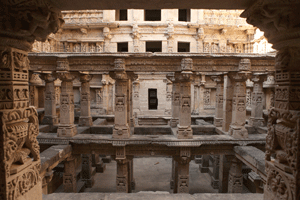
The stepwells of Gujarat are spiritual monuments to water and stark reminders of the increasing scarcity of this critical resource

Rani Ki Vav (Queen's Stepwell), Patan, Gujarat
(Samir S. Patel)
Descend into any of Gujarat's stepwells, and the first thing you might notice is the temperature change—though they are bone dry, it's nonetheless like stepping into a pool of cool water. The second sensation is disorientation. They are marvels of proportion and symmetry, but they're also recursive, Escher-esque, and vertiginous. The final impression, as you look up, down, and through the stepwell, is surprise that something as mundane as a well can be both monumental and intimate.
The stepwells of the western Indian state of Gujarat, known as vavs in Gujarati and baoris in Hindi, are part of an architectural tradition that goes back more than a thousand years. The typical vav consists of a long, straight staircase that leads to the bottom of a circular or octagonal well shaft, with landings and colonnades on each story along the way. The design is both a clever solution to the region's boom-and-bust monsoon cycle and a place of social and spiritual significance. In a more typical well, a vessel is lowered by a rope to gather water, but in stepwells people could walk to the water level—near the top just after the monsoon, and six or more stories down just before it—to collect water, bathe, and socialize.

To read more, find ARCHAEOLOGY in your local newsstand or bookstore, or click here to buy a copy of the issue online. And if you'd like to receive ARCHAEOLOGY in your mailbox, click here to subscribe.
Samir S. Patel is deputy editor of ARCHAEOLOGY.
Advertisement

Advertisement








